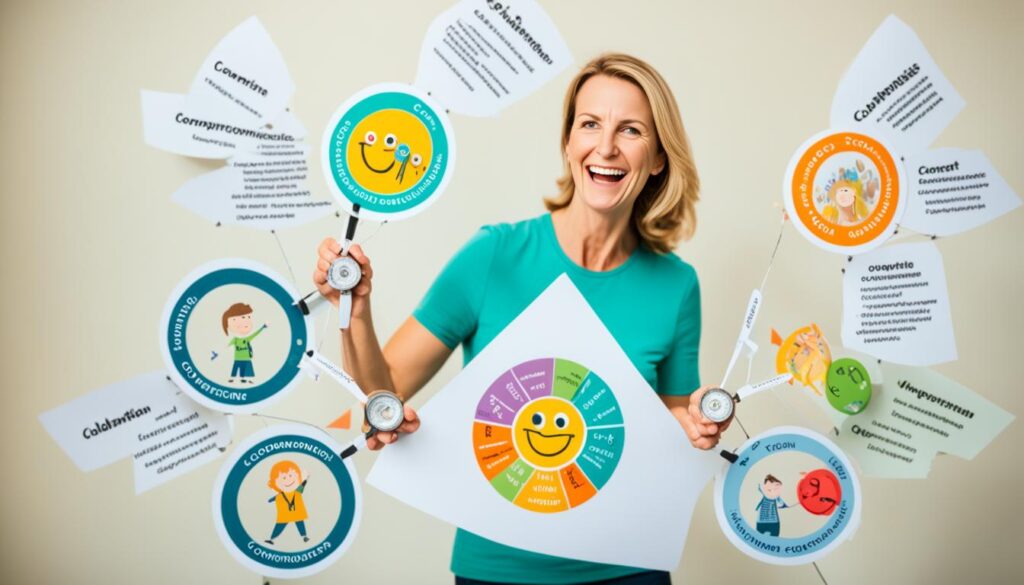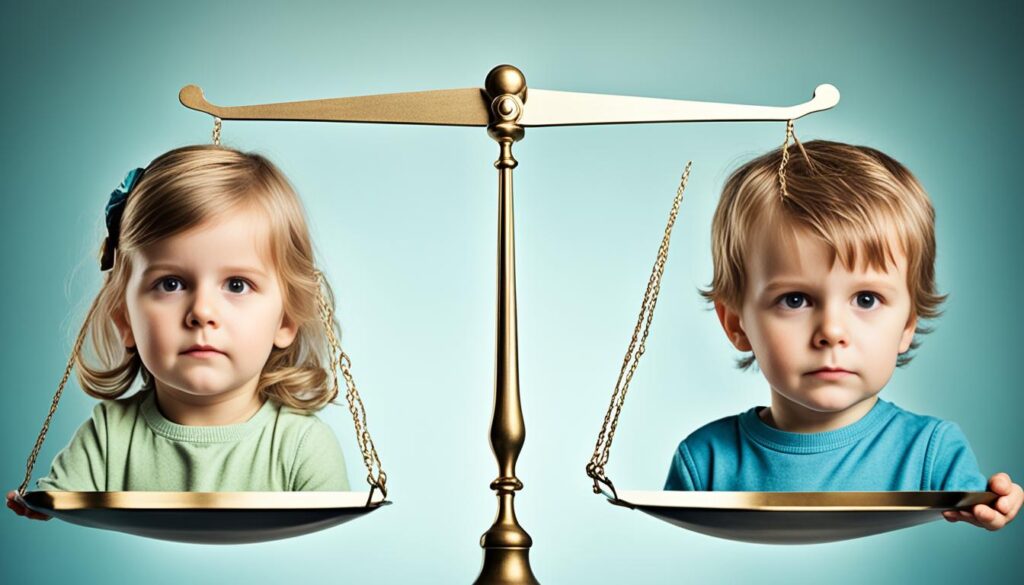Did you know that approximately 50% of marriages in the United States end in divorce? This situation often gives rise to complex child custody battles in high conflict divorces when children are involved. Navigating the complexities of parental rights, child custody laws, and divorce court processes is essential for effectively managing this challenging path.
Key Takeaways:
- Child custody battles are a common occurrence in high conflict divorces.
- Understanding child custody laws is crucial for navigating the process.
- Prioritizing the best interests of the child is of utmost importance.
- Open communication, flexibility, and compromise are essential for successful co-parenting.
- Mediation can be a valuable tool in reaching a custody agreement.
Child Custody Laws in California
When it comes to child custody battles in high conflict divorces, it is essential to have a thorough understanding of the child custody laws in California. Like most states, California follows the “best interests of the child” standard when determining custody arrangements. This means that the court looks at various factors to determine what custody arrangement would be most beneficial for the child involved.
The two main types of child custody in California are legal custody and physical custody. Legal custody refers to the right to make important decisions regarding the child’s upbringing, such as education, healthcare, and religious practices. Physical custody, on the other hand, determines where the child will live and spend their time. It is essential to understand the legal framework of these custody types when navigating child custody battles in high conflict divorces.
“California uses the ‘best interests of the child’ standard to determine custody arrangements.”
Legal Custody
Legal custody in California can be either joint or sole. Joint legal custody means that both parents have equal decision-making authority and must work together to make major decisions for the child. This includes decisions regarding the child’s education, healthcare, and religious upbringing. Sole legal custody, on the other hand, grants one parent the sole authority to make important decisions for the child. It is important to note that even if one parent has sole legal custody, the other parent may still have the right to be informed about and consult on major decisions.
Physical Custody
Physical custody in California can also be joint or sole. Joint physical custody means that the child spends significant time with both parents, often in a shared parenting arrangement. This allows the child to maintain a close relationship with both parents and have a stable living situation. Sole physical custody, on the other hand, means that the child primarily lives with one parent, and the other parent may have visitation rights. The court considers various factors, such as the child’s age, relationship with each parent, and the parent’s ability to provide a stable environment, when determining the most suitable physical custody arrangement.
Summary of Child Custody Laws in California
| Legal Custody | Physical Custody |
|---|---|
| Joint legal custody | Joint physical custody |
| Sole legal custody | Sole physical custody |
Impact of High Conflict Divorces on Children
In high conflict divorces, children bear the brunt of constant fighting and animosity between their parents. This tumultuous environment often leads to a range of negative emotions that can deeply impact a child’s well-being.
Children in high conflict divorces may experience feelings of anger, guilt, and confusion as they witness their parents’ frequent disputes. These negative emotions can take a toll on their mental and emotional health, affecting their overall development and happiness.
Additionally, children may find themselves caught in loyalty conflicts, torn between their parents’ opposing views and unable to express their own feelings freely. This internal struggle can leave children feeling trapped and unable to navigate their emotions effectively.
The Toll of Negative Emotions
Negative emotions experienced by children in high conflict divorces can have long-lasting effects on their relationships, self-esteem, and overall outlook on life.
“When children are exposed to constant conflict, it can have detrimental effects on their psychological well-being. They may struggle with trust, have difficulty forming healthy relationships, and experience higher levels of anxiety and depression. It is crucial to recognize and address these emotional challenges to protect the child’s long-term well-being.”
It is important for parents and other involved parties to understand the profound impact that high conflict divorces can have on children. Recognizing the emotional toll and taking steps to mitigate these negative effects is essential when navigating child custody disputes.
Supporting Children in Loyalty Conflicts
Loyalty conflicts can be especially challenging for children in high conflict divorces. They may feel torn between their parents’ conflicting demands, opinions, and expectations. This conflict can leave children feeling pressured to choose sides, suppressing their own thoughts and emotions in the process.
It is crucial for parents to create a safe and supportive environment where children feel empowered to express their feelings openly and honestly. By validating their emotions and reassuring them that their loyalty and love for both parents is valid, parents can help alleviate the stress and confusion children experience in loyalty conflicts.
Additionally, seeking the guidance of a therapist or counselor with experience in high conflict divorces can provide children with the necessary tools to navigate loyalty conflicts and develop healthy coping mechanisms.
By addressing the impact of high conflict divorces on children and actively working to minimize the negative emotions and loyalty conflicts they face, parents can create a more stable and nurturing environment for their children’s well-being during the challenging process of child custody disputes.

Important Considerations for Parents
During high conflict divorces, parents must prioritize the well-being of their children. The child’s emotional and mental health should be at the forefront of decision-making, and parents must work together to create a stable and supportive environment for their children.
Open communication is essential in high conflict divorces. Parents should strive to maintain respectful and honest conversations, focusing on the child’s needs rather than personal grievances. By fostering open lines of communication, parents can ensure that important decisions regarding the child’s upbringing are made collaboratively.
Keeping children out of adult conflicts is crucial for their well-being. They should not be burdened with the weight of their parents’ disputes or used as pawns in ongoing conflicts. Shielding children from adult disagreements allows them to maintain a sense of normalcy and protects their emotional and psychological health.
It is important for parents to be flexible and willing to compromise for the sake of their children. In high conflict divorces, rigid attitudes and unwillingness to work together can negatively impact the child’s well-being. By displaying flexibility and a willingness to find common ground, parents can create a more stable and nurturing environment for their children.
Putting aside personal differences and focusing on the child’s best interests is key in navigating child custody battles in high conflict divorces. This requires parents to be selfless and prioritize the needs and happiness of their children over their own desires or grievances. By approaching the situation with empathy and a genuine commitment to what is best for the child, parents can navigate high conflict divorces with their child’s well-being as the central focus.
| Important Considerations for Parents: |
|---|
| Maintain open communication |
| Keep children out of adult conflicts |
| Be flexible and willing to compromise |
| Focus on the child’s best interests |

The Role of Mediation in High Conflict Divorces
In high conflict divorces, where tensions run high and emotions often get in the way, finding a resolution for child custody disputes can be extremely challenging. This is where mediation plays a crucial role in helping parents navigate the difficult terrain and reach a custody agreement that is in the best interests of the children involved.
Mediation involves the intervention of a neutral third party, known as a mediator, who facilitates communication and negotiation between the parents. Unlike a courtroom setting, mediation provides a more collaborative and cooperative environment, allowing parents to have an active role in shaping their custody agreement.
One of the key benefits of mediation in high conflict divorces is its ability to reduce conflict between parents. By engaging in open and constructive dialogue, parents often find common ground and develop a better understanding of each other’s perspectives. This process lays the foundation for positive co-parenting relationships, which are essential for the well-being of the children.
Benefits of Mediation in High Conflict Divorces:
- Reduces conflict between parents
- Promotes open and constructive communication
- Fosters positive co-parenting relationships
- Allows parents to have an active role in decision-making
- Provides a more flexible and tailored custody agreement
In California, mediation is not just a recommended approach, but a requirement before a court hearing for child custody cases can take place. This demonstrates the state’s recognition of the effectiveness of mediation in resolving high conflict divorces and ensuring the well-being of the children involved.
By choosing mediation as a means of resolving child custody disputes, parents can work together to create a custody agreement that takes into account the unique needs and interests of their children. This collaborative approach empowers parents to find solutions that work for everyone involved, fostering positive relationships and ultimately helping children thrive in the midst of a high conflict divorce.

Child Custody Battles and the Best Interests of the Child
When navigating child custody battles in high conflict divorces, our primary focus should always be the best interests of the child. It is essential to remember that the court’s ultimate goal is to ensure the child’s well-being and promote a positive co-parenting relationship.
In the state of California, child custody laws prioritize the child’s best interests by considering several factors. These factors include the child’s health, safety, and welfare, as well as any history of domestic violence or substance abuse. The court also takes into account the child’s relationship with each parent and their ability to provide a stable and supportive environment.
By prioritizing the child’s well-being, parents can play a vital role in creating a positive co-parenting relationship. This involves effective communication, mutual respect, and a willingness to cooperate for the child’s sake. It is important to set aside personal differences and focus on the child’s needs and desires.
To illustrate the impact of child custody battles on children and the significance of their best interests, consider the following table:
| Effects of Child Custody Battles on Children | Importance of the Child’s Best Interests |
|---|---|
| 1. Emotional distress, anxiety, and confusion | A child’s emotional well-being is crucial for their overall development and happiness. |
| 2. Loyalty conflicts, feeling torn between parents | |
| 3. Negative impact on academic performance and social relationships | |
| 4. Long-lasting psychological effects | Child custody battles can have long-term consequences on the child’s mental health, leading to issues in adulthood. |
Therefore, it is essential to approach child custody battles with the child’s best interests as the guiding principle. By focusing on their well-being and promoting a positive co-parenting relationship, parents can reduce the negative impact of the custody battle on the child. Remember, in the end, it is the child who needs our support and care the most.

The Challenges of High Conflict Custody Cases
High conflict custody cases can bring about a range of challenges, from intense disputes and emotional intensity to frequent court involvement. These cases often have a profound impact on the well-being of the child involved, necessitating careful navigation and professional intervention. The ongoing conflict can create divided loyalties for the child and contribute to emotional distress. In some instances, the involvement of mediators or therapists becomes crucial in managing and mitigating the effects of the conflict.
One of the primary challenges in high conflict custody cases is the intense disputes that arise between the parents. The disagreements and conflicts can escalate quickly and become emotionally charged, making it difficult to reach a resolution. The animosity and hostility experienced by both parties can prolong the legal process and further exacerbate the emotional strain on the child.
The emotional intensity in these cases can be overwhelming for all involved, including the child. The child may witness or be caught in the crossfire of heated arguments and confrontations, leading to significant emotional distress. The child’s well-being can be jeopardized as they navigate the conflicting demands and expectations of each parent, causing confusion, anxiety, and even depression.
“High conflict custody cases often require the intervention of professionals, such as mediators or therapists, to address the emotional intensity and help manage the effects on the child.”
Court involvement is frequently a central aspect of high conflict custody cases. The parents may find themselves engaged in legal battles, seeking temporary or permanent custody arrangements, or attempting to modify existing orders. The court process can be lengthy, expensive, and emotionally draining for all parties, including the child. The child may be subjected to interviews, evaluations, and ultimately, judicial decisions that can greatly impact their life and well-being.
The impact of high conflict custody cases on the child cannot be underestimated. The ongoing conflict between the parents can lead to divided loyalties, with the child feeling torn between both sides. The child may be pressured to take sides or be used as a pawn in the parents’ disputes. This can have a detrimental effect on the child’s mental health, relationships, and overall development.
To effectively navigate the challenges of high conflict custody cases, it is essential to prioritize the well-being of the child. Professional help, such as mediation or therapy, can provide a safe space for communication and conflict resolution. It is important to seek the support of qualified professionals who can guide the process and help mitigate the emotional intensity.

| Challenges | Effects |
|---|---|
| Intense disputes | Protracted legal battles |
| Emotional intensity | Confusion, anxiety, and depression in the child |
| Court involvement | Lengthy, expensive, and emotionally draining process |
| Impact on the child | Divided loyalties, strained relationships, and negative effects on mental health and development |
Strategies to Navigate High Conflict Custody Cases
In high conflict custody cases, we understand the challenges and complexities that parents face. To effectively navigate these situations, it is crucial to employ various strategies that prioritize the best interests of the child and strengthen your case. Here are some key strategies to consider:
- Seek Legal Counsel: When dealing with high conflict custody cases, it is important to seek legal counsel with experience in this area. An experienced attorney can guide you through the legal process and provide valuable advice tailored to your specific situation.
- Maintain a Child-Centered Approach: Keeping the best interests of the child at the forefront is essential. Focus on creating a stable and nurturing environment that promotes the child’s well-being and development. This includes considering their physical, emotional, and educational needs.
- Effective Communication: Clear and respectful communication is key, both with the other parent and any professionals involved in the case. Avoid engaging in confrontations or arguments and instead prioritize open and constructive dialogue that focuses on the child’s needs.
- Documentation: Keep detailed records of all interactions and incidents related to the custody case. This documentation can serve as evidence and strengthen your position during court proceedings. Include dates, times, and descriptions of any significant events or conversations.
- Follow Court Orders: Adhering to court orders demonstrates your willingness to comply with the legal process and act in the best interests of the child. Failure to follow court orders can negatively impact your case.
- Take Care of Yourself: Self-care is crucial during high conflict custody cases. Seek support from friends, family, or therapists to help you navigate the emotional challenges that may arise. Taking care of your own well-being enables you to better support your child.
- Be Prepared for Evaluation: In some instances, high conflict custody cases may involve evaluations, such as psychological assessments or home visits. Prepare for these evaluations by being truthful, cooperative, and demonstrating your commitment to providing a safe and nurturing environment for your child.
We understand that high conflict custody cases can be emotionally draining and challenging. By employing these strategies, you can navigate the complexities of the legal system while prioritizing the well-being of your child. Remember, the ultimate goal is to create a positive and stable environment for your child to thrive in.

| Benefits of Strategies | Effective Communication | Documentation | Maintain a Child-Centered Approach |
|---|---|---|---|
| Strengthens your case | Ensures clear understanding | Serves as evidence in court | Prioritizes the child’s well-being |
| Improves co-parenting relationship | Reduces misunderstandings | Provides a record of interactions | Considers the child’s needs |
| Enhances communication with professionals | Fosters cooperation | Strengthens your credibility | Promotes a nurturing environment |
Resolving High Conflict Custody Cases
In high conflict custody cases, finding resolution can be a challenging and complex process. However, there are various methods that can be employed to help resolve these difficult situations and prioritize the best interests of the children involved.
Mediation: A Path Towards Resolution
Mediation is often a recommended approach in high conflict custody cases. It involves engaging the services of a neutral third party who facilitates communication and helps parents reach a mutually agreeable solution. Through open and guided discussions, mediation allows parents to work together to find common ground and develop a custody agreement that benefits the children.
Mediation is a valuable tool in high conflict divorce situations, enabling parents to make decisions regarding their children with the help of a neutral third party. It allows for solutions that prioritize the child’s best interests and can often lead to more satisfactory outcomes compared to court battles.
During mediation, parents have the opportunity to express their concerns, address contentious issues, and explore alternative possibilities that cater to the needs of their children. This collaborative approach can significantly reduce conflict and create a foundation for positive co-parenting relationships in the future.
Court Intervention: When Mediation Falls Short
While mediation is generally preferred, there are instances where court intervention becomes necessary. In high conflict custody cases where mediation fails to produce an agreement, the court takes on a decision-making role. This involves formal court hearings where evidence is presented, and a judge makes a determination based on the child’s best interests.
Court intervention should be approached with the understanding that it may heighten conflict and strain relationships. However, in cases where children are at risk or when progress remains stagnant despite mediation efforts, court intervention brings a level of finality and authoritative decision-making.
Focusing on the Child’s Best Interests
Throughout the process of resolving high conflict custody cases, it is crucial to maintain a steadfast focus on the child’s best interests. This means considering their emotional well-being, stability, safety, and overall growth. Every decision made should have the child’s welfare at the center, even amidst parental disagreements.
Resolving high conflict custody cases requires a comprehensive understanding of each child’s unique needs and circumstances. This knowledge helps guide the decision-making process and ensures that the children are shielded from unnecessary conflict and can thrive in a nurturing environment.

Implementing the strategies discussed in previous sections, such as effective communication, flexibility, and a child-centered approach, can greatly aid in finding resolution in high conflict custody cases. Seeking professional advice and guidance during the process can also provide valuable insights and support.
Remember, the ultimate goal is to prioritize the child’s best interests, fostering a positive and stable environment where they can grow and flourish. By dedicating attention and effort to finding resolution, even in the most challenging custody battles, parents can help set the foundation for a brighter future for their children.
Conclusion
Navigating child custody battles in high conflict divorces can be a daunting and emotionally challenging process. However, by focusing on the best interests of the children, maintaining effective communication, and seeking appropriate legal guidance, parents can work towards positive co-parenting relationships and prioritize the well-being of their children.
It is important to remember that the goal should not be to “win” the custody battle, but rather to create a positive and stable environment in which the children can thrive. This involves putting aside personal differences and prioritizing the needs of the children above all else.
By working collaboratively with the other parent and considering the children’s best interests, parents can ensure that the child custody agreement reflects their rights as parents while emphasizing the child’s well-being. Seeking professional support, such as mediation or therapy, can also be beneficial in resolving conflicts and facilitating effective co-parenting.
Ultimately, the success of navigating child custody battles in high conflict divorces lies in the ability of parents to focus on creating a nurturing and supportive environment for their children. By prioritizing open communication, cooperation, and the child’s best interests, parents can successfully navigate this challenging process and ensure the well-being of their children in the face of adversity.
FAQ
What factors does California consider when determining child custody arrangements?
California considers factors such as legal custody (decision-making authority) and physical custody (where the child will live and spend time) when determining child custody arrangements.
How do high conflict divorces impact children?
High conflict divorces can expose children to constant fighting and lead to negative emotions such as anger, guilt, and confusion. Children may also struggle with loyalty conflicts, feeling torn between their parents’ opposing views.
What are some important considerations for parents in high conflict divorces?
Parents should prioritize their children’s well-being by maintaining open and respectful communication, keeping children out of adult conflicts, and being flexible and willing to compromise.
Is mediation helpful in high conflict divorces?
Yes, mediation is a valuable tool in high conflict divorces as it allows parents to work together with the help of a neutral third party to reach a custody agreement. This approach can reduce conflict and maintain positive relationships with both parents.
What is the court’s main concern in child custody battles?
The court’s main concern in child custody battles is the best interests of the child. It considers various factors to determine the custody arrangement that would be most beneficial for the child.
What are the challenges of high conflict custody cases?
High conflict custody cases are characterized by intense disputes, emotional intensity, and frequent court involvement. These cases can have a significant impact on the well-being of the child involved.
What strategies can help navigate high conflict custody cases?
Strategies to navigate high conflict custody cases include seeking legal counsel with experience in dealing with such cases, maintaining a child-centered approach, effective communication, and documentation of interactions.
How are high conflict custody cases resolved?
High conflict custody cases can often be resolved through mediation or alternative dispute resolution methods outside of court. However, court intervention may be necessary in some cases. The focus should always be on the child’s best interests.
How can parents ensure the well-being of their children in child custody battles?
By prioritizing the best interests of the children, maintaining effective communication, and seeking legal guidance, parents can work towards positive co-parenting relationships and ensure the well-being of their children.
What is the ultimate goal in child custody battles?
The ultimate goal in child custody battles is not to “win” but to create a positive and stable environment for the children to thrive in, prioritizing their well-being and safety.










